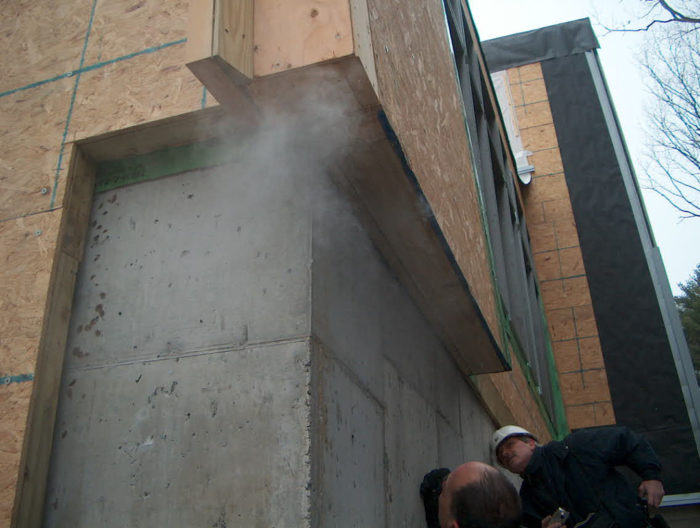
Image Credit: Image #1: Dale Caldwell
In the last few years, energy consultants have developed a quick and easy way to pinpoint air leaks in a building envelope. The technique uses a theatrical fog machine — a small, inexpensive device that creates smoke-like fog for dances, Halloween parties, or theatrical events. Fog machines have heating elements that vaporize “fog juice,” a solution of water and glycol or water and glycerin.
With the help of a blower door or a window fan, a fog machine can dramatically reveal holes in a building envelope.
With air leaks, it’s all about location, location, location
For the last 30 years, energy raters have been using blower doors to determine a building’s leakiness. The results of a blower-door test — reported as infiltration airflow (in cfm) at a pressure difference of 50 Pascals — usually reveal how tight a building is, but not the location of any leaks.
Once a house is depressurized, however, air leaks can be located by walking from room to room feeling for drafts, or by waving a smoke pencil near likely problem areas. Finding these leaks requires experience, persistence, and a certain amount of detective work. (For more information on blower-door testing, see “Blower Door Basics.”)
The fog-machine technique adds a whole new dimension to leak discovery. It’s leak detection for dummies. Instead of crawling around on your hands and knees with a smoke pencil, you look for leaks by standing around in the front yard. The leaks don’t reveal themselves as subtle whiffs of moving air; they shout, “Over here! I’m leaking!”
The fan blows inward
During a conventional blower-door test, the fan is set up to blow outward, depressurizing the house. A fog test, on the other hand, requires the house to be pressurized, with the fan blowing inward. Fog tests are usually scheduled…
Weekly Newsletter
Get building science and energy efficiency advice, plus special offers, in your inbox.

This article is only available to GBA Prime Members
Sign up for a free trial and get instant access to this article as well as GBA’s complete library of premium articles and construction details.
Start Free TrialAlready a member? Log in





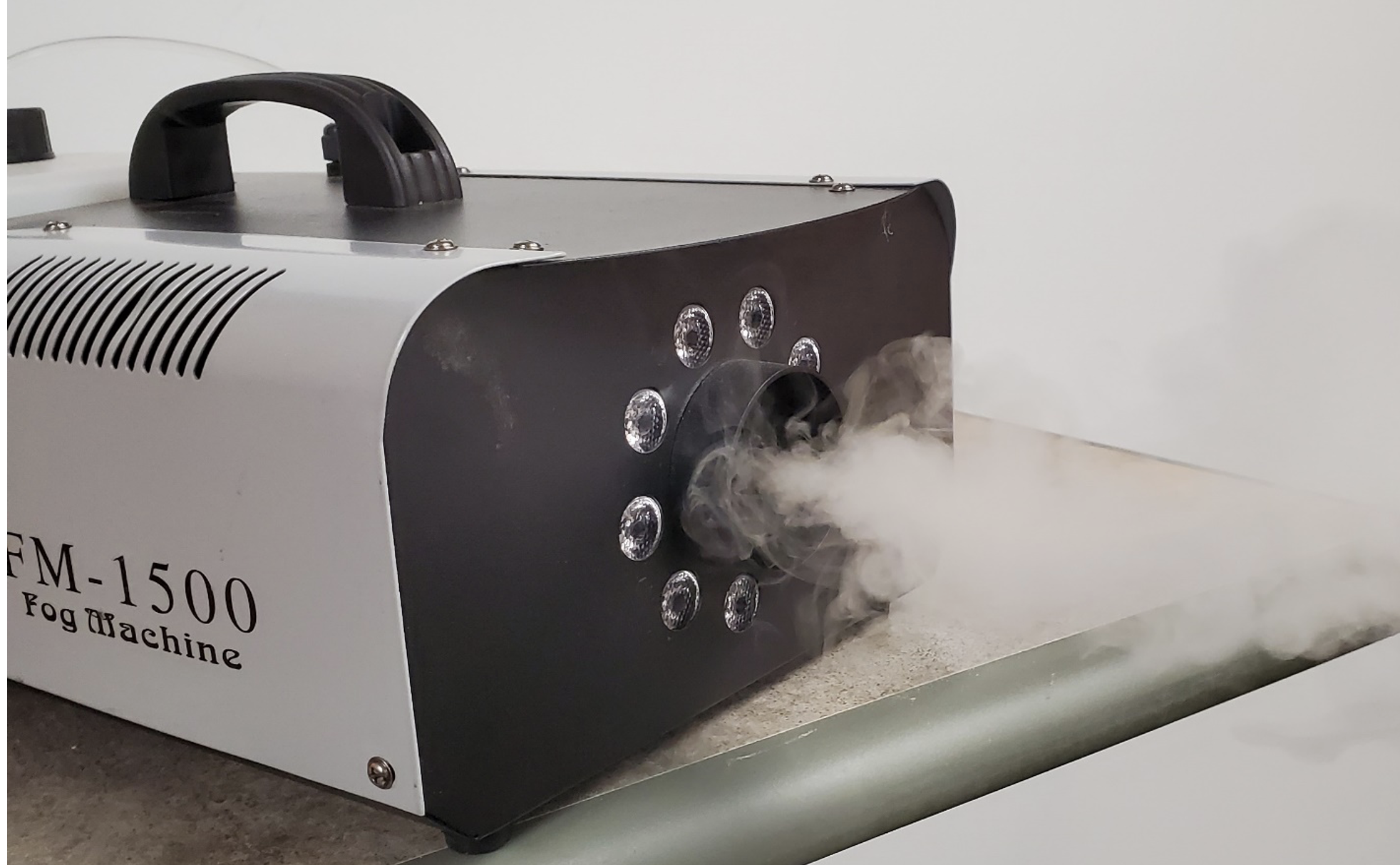
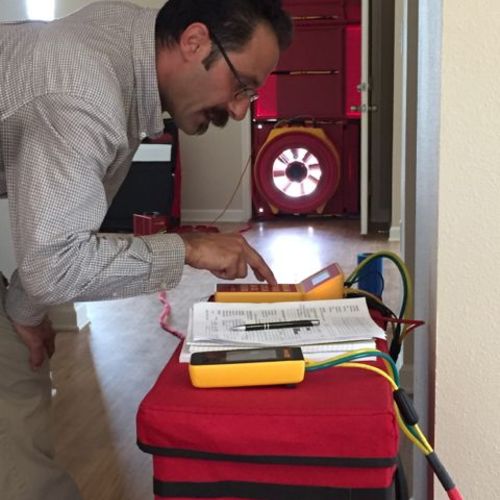
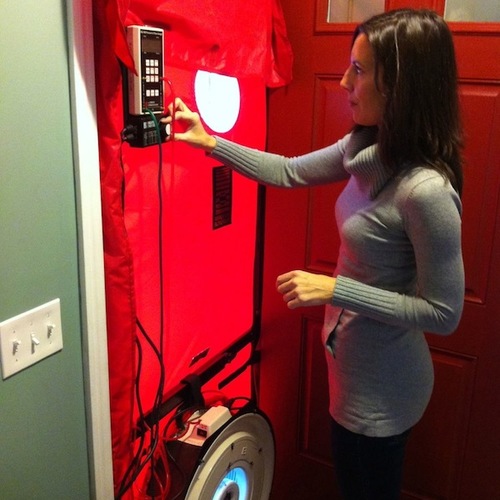
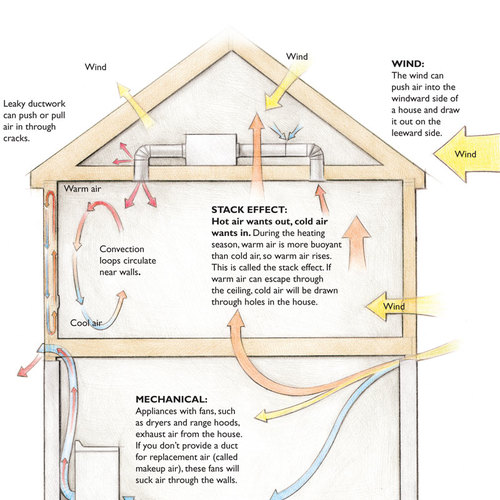






20 Comments
Thanks!
Martin,
Thanks for the great article. I've used fog machines to find leaks in ductwork, but this is something I hadn't thought of before. What a no-brainer!
I imagine this will be useful when testing very tight buildings, especially ones looking to meet the Passive House air-tightness standard (or similar). When a house tests just slightly over 0.60ACH50, it can be very difficult to find the culprits from the inside. The fog should prove to be useful in pinpointing these sometimes pin-sized leaks.
What about Existing Construction?
Do you think there would be any harm to use this technique in an existing ..furnished home?
They use fog machines indoors ... but ..hmmm
Any issues with residue?...or harmful condensation?
Fog machine vs. Life Safety Systems
I just want everyone to think about enclosing the smoke heads in zip lock sandwich bags (cut open the bottoms and tape them around the base of the smoke detectors and then zip them shut.
If you don't you will have to clean out the smoke detectors before you can bring your systems back on line.
Things to think about.
In furnished homes?
John,
The best time to air seal a house, as I'm sure you know, is during the construction phase. To air seal an existing occupied house, I would use traditional blower-door-directed air sealing methods (feeling for drafts and using a smoke pencil).
People use fog machines indoors all the time, but it's possible to overdo it. One Web site notes, "If you use a lot of fog you will get a very thin film of fog fluid residue on everything in the room, including people. My wife says it moisturizes her skin. Most fog fluids are made of glycol (kind of like mineral oil) and water, so it shouldn't do any damage, but feels sticky. If you have expensive furniture, etc., you make want to remove it or use the fog machine in a different room."
Smoke detectors
Ed,
Fog machines are used for theatrical events in buildings with smoke detectors. Again, the main point is not to overdo it. One Web site notes, "Smoke detectors sense particulate density in the air and cannot differentiate between smoke particulate and fog machine vapor. However, it's not impossible to use a fog machine in a room with smoke detectors, but it can be tricky. All it takes is a little skill and experimentation. You see, most smoke detectors will go off only after a certain density threshold is exceeded, so the key to success is to find out what that threshold is, and carefully keep your fog underneath of it."
Fog and occupants IAQ
Has anyone determined there is no added IAQ risk to a potential building occupant by theatrical fogging their whole brand new house or delivery duct system? I like the visual evidence that fogging produces, But can a homebuyer / occupant bring liability threats to a builder that used theatrical fog? I've seen fog mixtures (admittedly, the party store stuff) , which state not to introduce to known asthmatics. Does the professional mix have any disclaimers about their fog mix to chemical / allergic sensitive people?
IAQ
Kevin,
Fog machines are used for less than an hour during the construction phase of a project. Once the test is complete, there's no reason the contractor can't open every window in the house during a windy day. There's a lot of work that happens AFTER a fog test -- I'll list the work to give you an idea of how many days elapse between the brief fogging and the arrival of the happy homeowners:
Hang drywall
Tape and finish drywall
Trim windows, doors, baseboards
Install finish flooring
Install kitchen cabinets
Paint
Install toilets, sinks, vanities, lavatories
Install electrical trim
Of course, I'm sure I forgot a few trades. The point is, by the time the homeowners arrive, the fog machine was ancient history -- and the polyurethane used on the floor and the paint on the walls are far more likely to raise concerns.
THAT SAID, many homeowners express IAQ concerns that have no basis in science or fact. If you have such a client, all bets are off.
additional perspective
A few things to add to the discussion:
1) If you're leakage is down to the PH standards that John Semmelhack mentions, you probably won't see any fog at all. The pinprick-size holes can actually be really hard to pick up with the fog. It's much better for the bigger leaks and bypasses.
2) We find it's sometimes better to de-pressurize the house (as with a regular blower door test) and carry the fog machine around the outside, so the fog gets sucked into the house. Sometimes the leakage area is very diffuse on the outside but very focused on the inside--so sucking the fog into the house shows the leak better than blowing the fog outside. Since the fog machine works by heating up the glycol, in cold weather you may only get a few minutes of fog before the machine cools down and stops producing, so you have to work fast if you're using this outside-in strategy in the winter.
3) The first time we did the test a neighbor called the fire department, which added to the entertainment value considerably. If you're not into entertainment value, it may be worth a preemptive call if you're in a densely developed area.
4) We've used the technique in finished homes without adverse affect. The first time we did it was in an old basement and we were trying to find mouse entry points. It worked great for that. We've done the fog in several finished homes and have never been sued--at least not yet.
5) Do not, as a practical joke, fill with fog a car owned by any prominent HVAC engineer. And don't ask me how I know, because I have been sworn to secrecy.
Moisture
At the risk of sounding skeptical. I am uncomfortable with the idea of forcing moisture (fog) into a wall system. Do you have any research that this practice wont lower the r-value of the existing insulation within the wall. I would think blowing fog into a wall system insulated with any insulation that is not 100% hydrophobic would be a real bad Idea.
The house is pressurized for the test
Ben,
Fog only enters the wall through cracks or defects in the home's air barrier. (By the way, the visible part of the fog is not water vapor, as you assume, but glycol or glycerin.) The house is pressurized during the testing. Once the fog machine is turned off, the blower door or fan can continue to operate for a few minutes. The fan will continue to force air through exactly the same cracks where the fog was going.
If residual fog within the walls worries you — it's really a needless concern — then a few extra minutes of blower-door operation without the fog machine running will serve to blow fresh air through the cracks. More importantly, it will set your worrying mind to rest.
Sounds Great
Thank you for addressing my concerns. I work with an energy auditor who will be very interested in this technique.
My thoughts
Awesome
Fog Machines
Can this system be used to find leaks from rain? Or do you have another suggestion to find a leak that has been a long time problem?
Thanks for any help.
Response to Judy
Judy,
I have never heard of a roofer using a fog machine. The biggest problem with the idea: a home's air barrier is usually not aligned with the roofing. (For example, think of a house with an attic. The air barrier is at the ceiling drywall -- nowhere near the roofing.)
fogging the the duct system
I've only found one brand of fog juice, Rosco, that anyone in the fog machine OR energy conservation industries can tell me won't leave any residue in the ducts which in turn will attract dust. Or perhaps be harmful to the furnace/air handler. I've found one brand whose manufacturer says DO NOT use it for this purpose. So my question is, are there other brands (maybe cheaper and maybe easier to find) than Rosco that anyone actually knows won't be detrimental when introduced to ducts? I asked at The Energy Conservancy and their answer was,' "good question, no one's ever asked." Anyway, I can't afford a Rosco, I can't find one to rent, and I need a fogger but I am not willing to use a fog juice that may cause damage.
Response to Suzanne
Suzanne,
Good question. I suggest you post it on our Q&A page, where more people will see it (and perhaps come up with an answer). Here's the page:
https://www.greenbuildingadvisor.com/qa
Size of Fog Machine?
What size Fog Machine do Fennell and Rosenbaum use? Is it the Rosco 1900 like the picture indicates?
Up to what size house does their particular machine work properly before you have to start "baging" off different parts of the house?
Has anyone used a Chauvet Fog Machine?
Response to Tyson Dirksen
Tyson,
I'm not sure.
All I know is what I reported: "Both Fennell and Rosenbaum use Rosco fog machines that retail for about $400."
If you want more information, you should post your questions on the Q&A page:
https://www.greenbuildingadvisor.com/qa
RE: tyson
I have just recently ordered a Chauvet fog machine to use for locating leaks. I will let you know how the machine does. I bought the Chauvet fluid to go along with it because I read to beware of the cheap fluid. After seeing the Rosco prices I may have bought the cheap stuff without knowing it. The Rosco fluid is so expensive, I hope I can get by with this "cheap" fluid.
A pack of cigarettes, tape, plastic and a window fan and a flashlight would show up all but the tiniest of leaks.
Log in or become a member to post a comment.
Sign up Log in